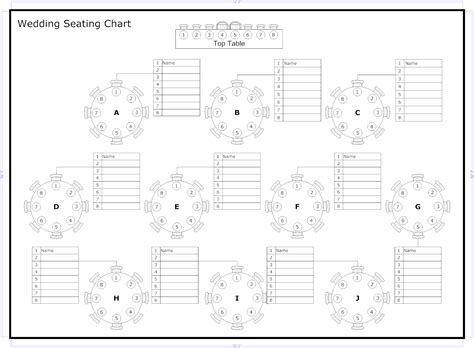Introduction

A seating chart is an essential element in planning any event, ensuring the comfort and satisfaction of attendees. Printing a seating chart can be a daunting task, but with the right tools and techniques, you can create a visually appealing and functional chart that will enhance the overall experience. This comprehensive guide will provide you with step-by-step instructions, best practices, and innovative ideas for creating a print seating chart that will elevate your event to the next level.
Understanding the Importance of a Print Seating Chart
A well-designed print seating chart serves several crucial purposes:
- Enhances attendee experience: Guests will appreciate knowing their designated seats, minimizing confusion and frustration.
- Optimizes space utilization: A seating chart allows you to efficiently arrange attendees in a space, ensuring maximum seating capacity and comfort.
- Facilitates communication: Staff can easily locate guests for announcements, food and beverage service, or any other event-related communication.
- Provides a record: A printed seating chart serves as a permanent record of the event, capturing the layout and attendee arrangements for future reference.
Step-by-Step Approach to Creating a Print Seating Chart
1. Gather Necessary Information:
- Determine the type of event and the number of attendees.
- Collect guest names, dietary restrictions, and any other relevant information.
- Identify the venue space and its seating capacity.
2. Choose a Seating Chart Software:
- Utilize event planning software or specialized seating chart applications with intuitive design tools.
- Consider software that offers customizable templates, easy drag-and-drop functionality, and export options for printing.
3. Create a Venue Layout:
- Draw a detailed diagram of the venue, including the stage, tables, chairs, and any other relevant features.
- Accurately scale the diagram to represent the actual dimensions of the space.
4. Arrange Seating:
- Assign guests to specific seats based on their preferences, group affiliations, or any other considerations.
- Use a color-coding system or other visual aids to differentiate different sections or groups.
5. Label and Number Seats:
- Clearly label and number each seat on the chart using a legible font and size.
- Ensure that each seat is uniquely identified and easy to read from a distance.
6. Print the Seating Chart:
- Export the seating chart in a high-resolution format for printing.
- Use durable paper stock to ensure the chart withstands repeated use during the event.
Best Practices for Effective Print Seating Charts
- Plan Ahead: Start creating the seating chart as early as possible to avoid last-minute changes.
- Proofread Carefully: Review the seating chart thoroughly to eliminate any errors in names, seat numbers, or venue layout.
- Consider Accessibility: Ensure the seating chart is accessible to attendees with disabilities, providing wheelchair-accessible seating and clear pathways.
- Provide Clear Instructions: Include a legend or key on the chart explaining any color-coding or seating arrangements.
- Update Regularly: Make any necessary updates or adjustments to the seating chart as guests RSVP or changes occur.
Innovative Ideas for Enhancing Print Seating Charts
- Interactive Seating Charts: Utilize QR codes or mobile apps to allow guests to interact with the seating chart, check in, and find their seats effortlessly.
- Personalized Seating: Add a personal touch by incorporating guest names, photos, or special messages next to their seats.
- Digital Signage: Display the seating chart on digital screens or projectors to provide a dynamic and up-to-date visual reference.
- Gamified Seating: Introduce an element of fun by incorporating scavenger hunt elements or puzzles into the seating arrangements.
- Sustainability: Use eco-friendly printing materials and work with vendors who prioritize sustainable practices to minimize environmental impact.
Conclusion
A well-executed print seating chart is a valuable tool that can transform the attendee experience at any event. By following the step-by-step approach outlined in this guide, considering best practices, and implementing innovative ideas, you can create a seating chart that is both functional and aesthetically pleasing. Remember, the quality of your seating chart can leave a lasting impression on your guests, enhancing their satisfaction and making your event a memorable one.
Table 1: Benefits of Using a Print Seating Chart
| Benefit | Explanation |
|---|---|
| Enhanced Attendee Experience | Clear seat assignments minimize confusion and frustration. |
| Optimized Space Utilization | Efficient seat arrangements maximize seating capacity and comfort. |
| Facilitated Communication | Staff can easily locate guests for announcements or services. |
| Permanent Record | Printed seating chart serves as a record of the event layout and attendee arrangements. |
Table 2: Tips for Choosing a Seating Chart Software
| Feature | Importance |
|---|---|
| Intuitive Design Tools | Easy-to-use drag-and-drop functionality and customizable templates. |
| Export Options | High-resolution export options for professional printing. |
| Collaboration Features | Allows multiple users to work on the seating chart simultaneously. |
| Analytics and Reporting | Provides insights into guest preferences and seating patterns. |
| Customer Support | Access to technical support and guidance when needed. |
Table 3: Common Pain Points Addressed by a Print Seating Chart
| Pain Point | Solution |
|---|---|
| Confusion and Delays | Clear seat assignments reduce confusion and streamline check-in processes. |
| Inefficient Space Utilization | Optimized seating arrangements maximize capacity and minimize overcrowding. |
| Miscommunication | Staff can easily locate guests for announcements or dietary restrictions. |
| Lack of Documentation | Printed seating chart provides a record of event layout and guest arrangements. |
Table 4: Innovative Ideas for Print Seating Charts
| Idea | Impact |
|---|---|
| Interactive Seating Charts | Enhances attendee engagement and provides a unique experience. |
| Personalized Seating | Adds a personal touch and makes guests feel valued. |
| Digital Signage | Provides a dynamic and up-to-date visual reference for guests. |
| Gamified Seating | Introduces an element of fun and encourages guest participation. |
| Sustainability | Reduces environmental impact by using eco-friendly materials and practices. |
